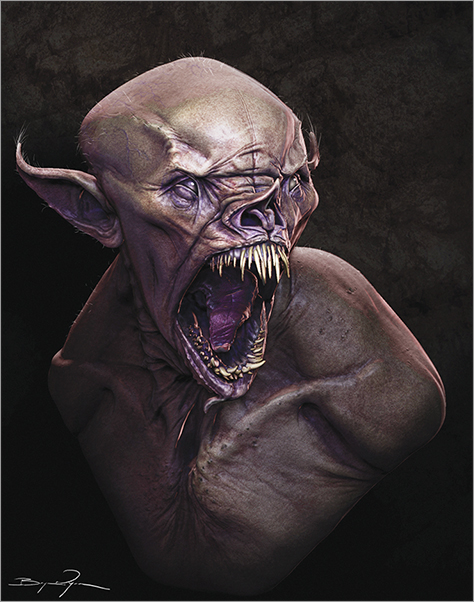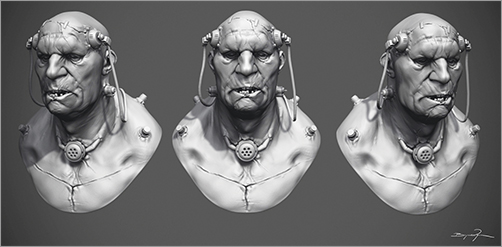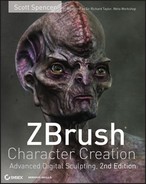You are now ready to apply your knowledge of the theory behind ZSpheres and some of their basic controls to creating a biped character. Follow the steps in this section to build a humanoid armature and generate a polygon mesh as a base for sculpting. For a video of this process, see the accompanying DVD.
Don’t be too concerned with generating a highly accurate silhouette or intricate edge loops at this stage. The point of this exercise is to create a general base on which to sculpt. With the ZBrush topology tools, you can generate any kind of base mesh you like after the sculpting is done.
1. Initialize ZBrush to clear any previous tools from the palette and the canvas. From the Tool menu select the ZSphere tool and draw the root sphere on the canvas. Press the T key to enter Edit mode. Open the main Transform menu and click the Activate Symmetry button, and then enable X Symmetry (Figure 6-15). This will create two circles for your cursor. When both become a single green circle, you know you are centered on the sphere before you draw a new child sphere. Drag and Shift-click to create the first child. If you see only two dots, that means you are looking at the side, so rotate to view the top of the sphere.
Figure 6-15: Activate X Symmetry under the Transform menu.

2. Rotate to the other side of the root sphere and repeat the process of creating a child. The resulting chain should look like Figure 6-16. Notice how the orientation of the ZSpheres flips on either side of the center root sphere. This is normal. Press the A key to turn on Preview Adaptive Skin. Your skin should look like a capsule, as shown in Figure 6-17.
Figure 6-16: The initial ZSphere chain
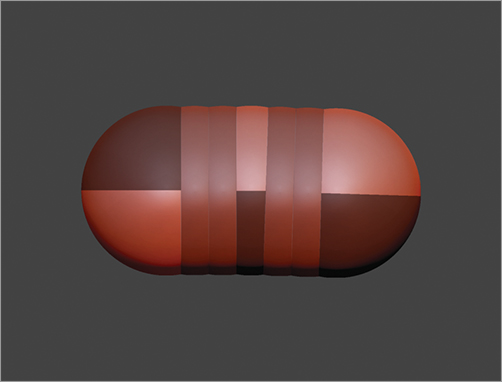
Figure 6-17: The adaptive skin from this mesh should look like a capsule.

3. This “capsule” will form the torso of your biped. Now you need to add arms and legs. Rotate to a side view and turn off Y Symmetry; be sure to keep X symmetry on. Draw a ZSphere at the shoulder by click-dragging on the side of the top sphere. This will create a child linked to the top, as shown in Figure 6-18. Repeat this process on the bottom sphere to create the hip spheres. Remember that your cursor will turn green when you reach the centerline of a ZSphere. Try to draw new spheres when the cursor is green to get the best result from the mesh.
Figure 6-18: Creating the shoulder and hip ZSpheres
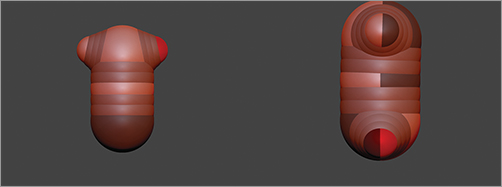
As you create a ZSphere model, be sure to press A often as you work—checking the Adaptive Skin Preview is the best way to catch mistakes early and save time and effort.
4. It’s time to add a neck and head. Rotate to the top view and draw a new ZSphere between the shoulder spheres. Drag and Shift-click twice to make a chain of three spheres the same size (Figure 6-19). This process creates a simple head mesh. For a more advanced technique with eye and mouth edge loops as well as ear geometry, see the section “Adding Edge Loops to the Head” later in this chapter.
Figure 6-19: Making the head and neck
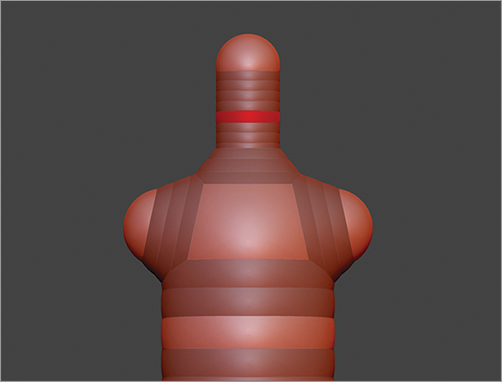
5. To add the arms, draw a ZSphere child from the shoulder ZSphere. Switch to Move mode (press the W key) and pull the sphere out from the sides. This sphere will be the wrist joint. Repeat the process for the legs (Figure 6-20).
Figure 6-20: Creating the legs

6. You now have a very rough block of the figure. Let’s now insert ZSpheres for the joints at the elbows and knees to further refine the gesture and proportion. Make sure you are in Draw mode by pressing the Q key or clicking the Draw button at the top of the screen![]() . Click between the shoulder and wrist spheres to add the elbow joints. Repeat this process for the legs. Your ZSpheres should look like Figure 6-21.
. Click between the shoulder and wrist spheres to add the elbow joints. Repeat this process for the legs. Your ZSpheres should look like Figure 6-21.
Figure 6-21: Placing the elbow and knee joints

7. Switch to Move mode and begin to adjust the gesture of the figure. Look for the natural bend in the elbows and knees. At this stage, you can also lengthen the torso and pull the neck forward (Figure 6-22). Scale the spheres of the head up by scaling the neck bone. You can add a sphere in the abdomen and scale it down as well as rotate the torso back slightly to add a bend to the spine.
Figure 6-22: The edits to the ZSphere chain create a stronger gesture and adjust proportion.

At this stage, you could move on to hands or add a few more ZSpheres to increase resolution and reinforce the curves of the figure. Usually I prefer to keep ZSphere chains as simple as possible, but adding these next few spheres to establish the rhythms of the body can be helpful. If you choose to skip these spheres, that’s fine—you can introduce the same curves in the sculpting phase.
1. Add a new ZSphere between the knee and hip spheres. Scale it up slightly and move it forward to give the thigh its characteristic curve.
2. Let’s use the same approach for adding curvature to the back of the calf. Move the sphere back after scaling so the front of the shin is straight while the back is curved (Figure 6-23). You can improve the transition between the calf and knee by making it a sharper turn. To do so, add another ZSphere between the knee sphere and the calf sphere (Figure 6-24).
Figure 6-23: Adding a ZSphere to give a more natural curve to the calf

Figure 6-24: You can improve the knee joint by adding one more sphere between the knee and calf.
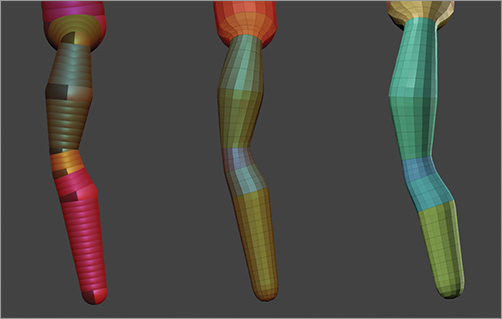
3. Add a sphere between the shoulders and elbow to serve as the mass of the upper arm (Figure 6-25). Also add a sphere on the upper arm close to the elbow to shape the join and make the arm appear less like a curved tube (Figure 6-26).
Figure 6-25: Using ZSpheres to refine the shape of the upper arm

Figure 6-26: Sharpen the transition from the upper arm to the elbow with an extra ZSphere.
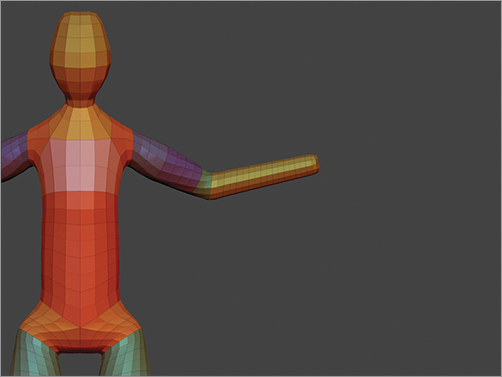
4. Add a sphere just below the elbow; this will serve as the forearm mass. The elbow transition can be further sharpened by adding another sphere between the forearm sphere just created and the elbow sphere (Figure 6-27).
Figure 6-27: An extra ZSphere below the elbow, and another between the elbow and forearm joint, will further define the transition between the upper and lower arm.

That completes the body for the figure. Your ZSphere chain and mesh should look like the one shown in Figure 6-28.
Figure 6-28: The ZSphere chain as it appears so far

Making Hands and Feet
Next, let’s add hands and feet to our ZSphere figure. There are several approaches to making extremities, some more complex than others. More involved approaches can offer animation-friendly topology right out of the adaptive skin, while less complex procedures offer a hand mesh that is ideal for sculpting with minimal effort. With the addition of topology tools in ZBrush 3, I find it is best to work with a simple ZSphere layout and build the animation mesh at a later time. This allows you to get to the sculpting phase faster, and the chances are a ZSphere mesh (much like any starting base mesh) will need to be tweaked for an animation pipeline. A simple process for making hands and feet follows.
1. Begin by drawing a hand sphere at the end of the arm chain. This new sphere will be the palm and all five fingers will be drawn from this sphere. Draw five spheres on this hand sphere (Figure 6-29a).
2. Move the thumb sphere down slightly. This will allow the four finger spheres more space in which to flow into the hand and also creates a more realistic placement for the fingers (Figure 6-29b).
3. Press A to preview the skin. The hand will mesh with each finger flowing logically into the palm (Figure 6-29c). This is a function of the new ZSpheres2 skinning system. In previous versions of ZBrush this method of making a hand with ZSpheres would not have been possible. We will look at the various methods of working with Adaptive skin settings later in this chapter.
This same process applies to feet as well. When you adjust the sphere placement, the foot shape can quickly be blocked out. In the next section we will look at some of the adaptive skin controls available in ZBrush.
Figure 6-29a:a The hand sphere drawn on the wrist

Figure 6-29b:b The thumb sphere moved down slightly

Figure 6-29c:c The ZSphere hand in preview mode

Adaptive Skin Controls
Throughout this chapter we have been using the A key to preview our mesh. What this is doing is creating an adaptive skin based on the ZSphere chain. As you recall, adaptive skins are like polygon socks stretched over the ZSpheres. You can control how the sock stretches as well as how dense it is by altering the adaptive skin controls. These are found under the Tool Adaptive Skin menu. It is important to note that between ZBrush 3.1 and 3.5 a new ZSphere skinning algorithm was introduced called ZSpheres2. This method of skinning helps create a mesh that much more closely resembles the volume and position of the underlying ZSphere chain.
Here you’ll find several sliders (Figure 6-30). We’ll go into more detail on those you’ll use often.
Figure 6-30: The Adaptive Skin menu contains sliders that control the way the polygon mesh generates from the ZSphere skeleton.

Preview The Preview button displays a preview of the adaptive skin. This is what we have been displaying with the A hotkey.
Density The Density slider ![]() controls how many subdivisions the skin will have. A setting of 3 will create a semi-smooth mesh of three divisions.
controls how many subdivisions the skin will have. A setting of 3 will create a semi-smooth mesh of three divisions.
G Radial The G Radial slider helps control the density of the mesh down the limbs by increasing the number of spans.
Max Twist Max Twist controls the twisting in the mesh, allowing you to adjust the way the edges flow in a forearm or any other area you want a twist in the topology. This slider functions by first selecting the sphere you want to adjust, then changing the slider setting. You can change the direction of the twist by entering negative values.
Proximity Tolerance Proximity Tolerance controls the way geometry intersects when many children ZSpheres come off a single parent.
Classic Skinning There is also a Use Classic Skinning button here that allows you to revert to the original ZSphere skinning methodology. The Classic Skinning method has many more sliders and options simply because the new standard ZSphere skinning method attempts to create the ideal mesh automatically based on the ZSphere skeleton you built. In some situations, this mesh may not be ideal for your purpose or preferences. In those cases, you can activate Classic Skinning and begin to adjust individual settings.
Classic Skinning
The Use Classic Skinning button under Adaptive Skin will switch ZBrush to the older method of skinning spheres (Figure 6-31). You may have techniques you prefer to use that rely on this skinning method, or you may just prefer the shapes it generates from your ZSphere chain. There are many reasons to keep this older workflow intact in the newer version of ZBrush, so we will examine some of the options next.
Figure 6-31: Classic Skinning options enabled under the Adaptive Skin menu

The Ires slider is intended to adjust the way the mesh reacts when multiple child meshes are growing from a single ZSphere. This is particularly important when working with hands. Figure 6-32 shows a ZSphere hand under Classic Skinning. Notice how the fingers become entangled and do not flow correctly into the palm. By changing the Ires slider to 3, you tell ZBrush to increase resolution on any sphere with more than three children (Figure 6-33).
Figure 6-32: The fingers do not flow correctly into the arm mesh under Classic Skinning if Ires isn’t set correctly.

Figure 6-33: Setting Ires to 3 corrects the issue with the finger resolution.

Minimal Skin To Child (Mc) allows the child sphere to determine the connection points of the mesh but not to add new geometry. This accounts for the V-shaped transition seen in the area that joins between the legs in Figure 6-34. Minimal Skin To Parent (Mp) allows the parent sphere to determine the connecting points. Figure 6-35 illustrates how turning on Mp can change topology as well as curvature in the wrist.
The Mbr slider controls membrane curvature, which is the curvature of the mesh between ZSphere intersections. When set to 0, this slider has no effect. As you raise the value, the transitions between spheres will change.
Figure 6-34: The effect of Minimal Skin To Child on the intersections of the mesh
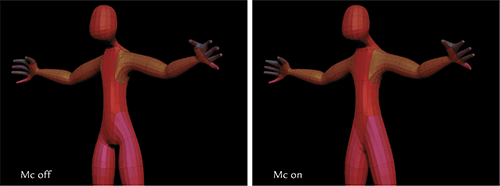
Figure 6-35: Minimal Skin To Parent can create a smoother transition into the wrist while removing the influence of the parent ZSphere on the topology.

You’ll see a difference between the two skinning methods in how closely the mesh follows the volume of the ZSpheres. You’ll also see differences in how hands, feet, and faces are created. Figure 6-36 shows the same ZSphere mesh under both skinning approaches. Notice how the facial edge loops are different between Classic and ZSpheres2 skinning. We’ll look at the facial edge loops in more detail next.
Figure 6-36: The same ZSphere model under both skinning methods

Finally, there is the Make Adaptive Skin button ![]() . When clicked, this button creates an adaptive skin from the ZSphere chain based on the Adaptive Skin settings. This new mesh is stored in the Tool menu, where you can select it and sculpt on it. Before you start sculpting your ZSphere base mesh into a character, you must convert it to an adaptive skin using this button. Table 6-1 shows the options under Adaptive Skin.
. When clicked, this button creates an adaptive skin from the ZSphere chain based on the Adaptive Skin settings. This new mesh is stored in the Tool menu, where you can select it and sculpt on it. Before you start sculpting your ZSphere base mesh into a character, you must convert it to an adaptive skin using this button. Table 6-1 shows the options under Adaptive Skin.
Table 6-1: Options in the Adaptive Skin subpalette
| Menu Option | Description |
| Preview | Previews the adaptive skin |
| Density | Sets the number of subdivision levels in the preview mesh as well as the resulting adaptive skin |
| G Radial | Controls the number of spans in the polygon mesh |
| Max Twist | Controls the twist of the resulting mesh |
| Proximity | Allows you to control how child ZSpheres are treated when in close proximity to the parent sphere |
| Use Classic Skinning | Reverts the skinning algorithm to ZBrush 3.1 methods; activates the settings below |
| Ires | Intersection resolution, which controls the number of children a ZSphere can have before it is converted to a high-res sphere |
| Mbr | Membrane resolution |
| Mc | Minimal Skin To Child |
| Mp | Minimal Skin To Parent |
| Pd | Adjusts the lowest subdivision level of the skin when using Insert Local Mesh or Connector Mesh |
| Make Adaptive Skin | Creates a polymesh based on the Adaptive Skin settings |
| Insert Local Mesh | Replaces a ZSphere in the chain with a ZTool selected from the Tool menu |
| Insert Connector Mesh | Replaces a connection between two ZSpheres with a tool selected from the Tool menu |
Adding Edge Loops to the Head
By adding a few more spheres to the head, we can give our model loops for the eyes and mouth as well as geometry to carry the nose. This ZSphere head is designed to allow for optimal edge loops for the eyes, nose, mouth, and ears.
Let’s begin with the neck sphere already drawn on the torso. Draw the head ZSphere on the neck and move it up away from the body (Figure 6-37). Press the A key to preview this head mesh. In the next steps we will be adding edge loops to the face. For this to work ideally, you will need to change your skinning method to Classic by choosing Tool Adaptive Skin and clicking Classic Skinning. The Classic method allows you to create edge loops with the techniques I am about to show. I have had some success with these methods under both skinning methods, so feel free to experiment.
Figure 6-37: Adding the head sphere
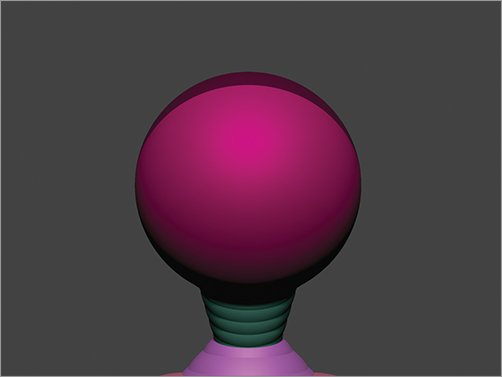
With X Symmetry on, draw two small ZSpheres for the eyes. Switch to Move mode and move them back into the head until they become concave holes instead of spheres (Figure 6-38).
Figure 6-38: Making the eye spheres

Draw a mouth sphere. Again, move it into the head to create a hole. Likewise, create spheres for the nose and ears (Figure 6-39). Press A to preview the mesh. Because we have Ires set to 3, any sphere with more than three children will automatically become a higher-resolution mesh, creating the loops for the eyes and mouth as well as extra geometry for the ears and nose. While this mesh may look extremely basic, almost cartoonish, now it is absolutely effective as a base for sculpting any number of realistic characters.
Figure 6-39: Creating the mouth, nose, and ears

You’ll notice the topology for the face is a bit awkward. It will serve our needs, but you may find you want a more organized base mesh for the face. Figure 6-40 shows the Classic Skinning result for the same ZSphere layout. This is a situation where you’ll find that the geometry created by Classic Skinning may be better than the new ZSpheres2 mesh. ZSpheres2 will create a triangular group of faces between the eyes and above the nose, as shown in Figure 6-40. The Classic Skinning method will create a cleaner topology but a less accurate volume to the rest of the mesh. It is up to you to decide which method best suits your needs for the model.
Figure 6-40: Facial loops with Classic and ZSpheres2 skinning

That concludes the process of creating the ZSphere armature. You have now a solid base mesh you can sculpt on without ever leaving ZBrush. We’ll sculpt in the major muscle forms and secondary forms of the face using the standard ZBrush sculpting tools, much as we did on the sphere in Chapter 2, “Sculpting in ZBrush.” ZSpheres work best as a quick and efficient mesh generation tool. Part of the strength of ZSpheres is the ease with which you can re-pose and change proportions by just moving and rotating the chain. Figure 6-41 shows the figure re-posed and reproportioned.
Figure 6-41: The ZSphere base mesh reproportioned and re-posed

Extreme changes to scale and placement of these spheres can yield a completely different type of character (Figure 6-42). It is also a simple matter to add in various parts. For instance, Figure 6-43 shows the same figure with centaur legs and bat wings.
Figure 6-42: The same ZSphere chain rescaled and re-posed to create a more hulking monster type of character. No new spheres were added here—I only made changes to the existing spheres.

Figure 6-43: New appendages, such as wings, can be added easily while existing limbs can be quickly reconfigured.

Remember to press Make Adaptive Skin and select the new ZTool when you are finished editing the ZSpheres. A common error is to try to work on the Adaptive Skin Preview mesh instead of saving a proper adaptive skin ZTool.
This concludes our look at building ZSphere bases for our characters. ZSpheres are a quick and powerful mesh generation tool that can help speed up your sculpting workflow by freeing you from many of the tedious base modeling tasks. The armatures built with ZSpheres are perfectly suitable for any kind of character or prop creation. Figure 6-44 shows a female figure sculpted from a ZSphere base by Ryan Kingslien. I encourage you to experiment with ZSphere modeling. With just a little practice, using the tools will become second nature and you will be generating base models in no time. For more information on ZSpheres and to see a full character sculpture from ZSphere—start to final detailed finish—see the accompanying DVD. I have included a time-lapse video of a werewolf creature sculpture that begins with a simple ZSphere base. The initial ZSphere mesh and final sculpture can be seen in Figure 6-45.
Figure 6-44: Highly realistic figures can be created from a ZSphere base—in this case, a female figure by Ryan Kingslien.

Figure: 6-45 See the DVD for the video process of sculpting this werewolf from ZSpheres.

Featured Artist: The Art of Bryan Wynia
Bryan is a talented creature artist who started in Makeup Effects at Bill “Splat” Johnson’s Lone Wolf FX. Bryan has a character-driven creative style that imbues his monsters with a sense of life and personality even at their most ferocious.

